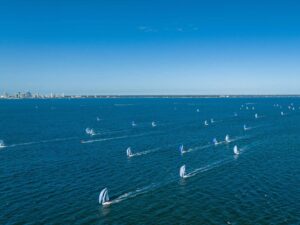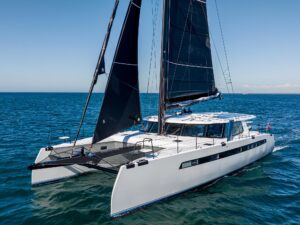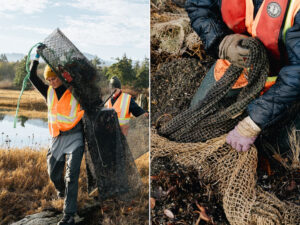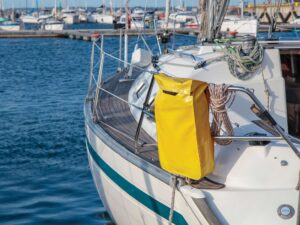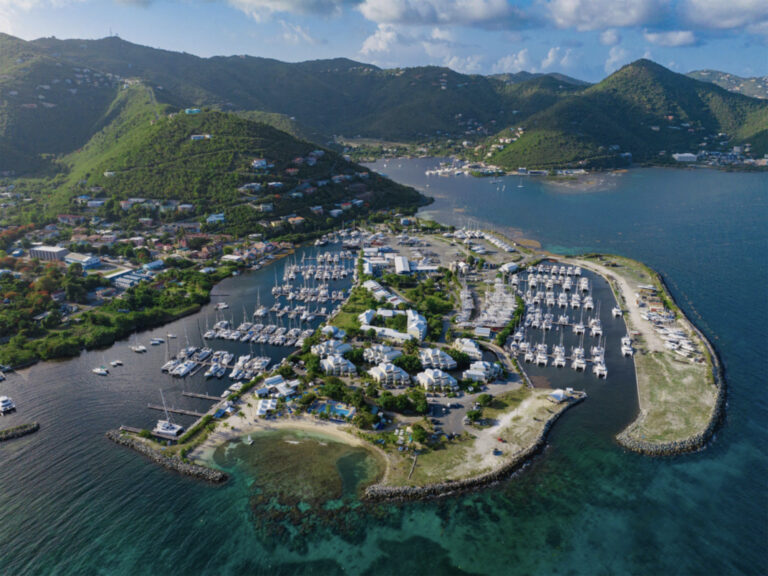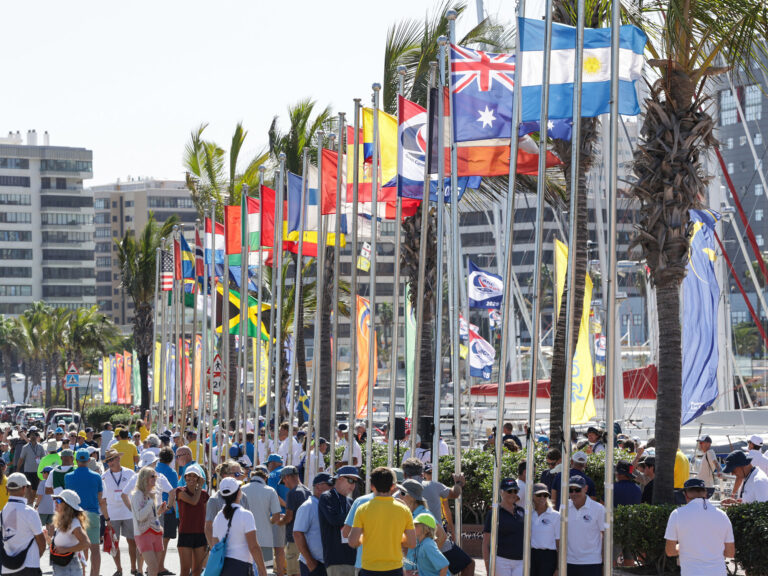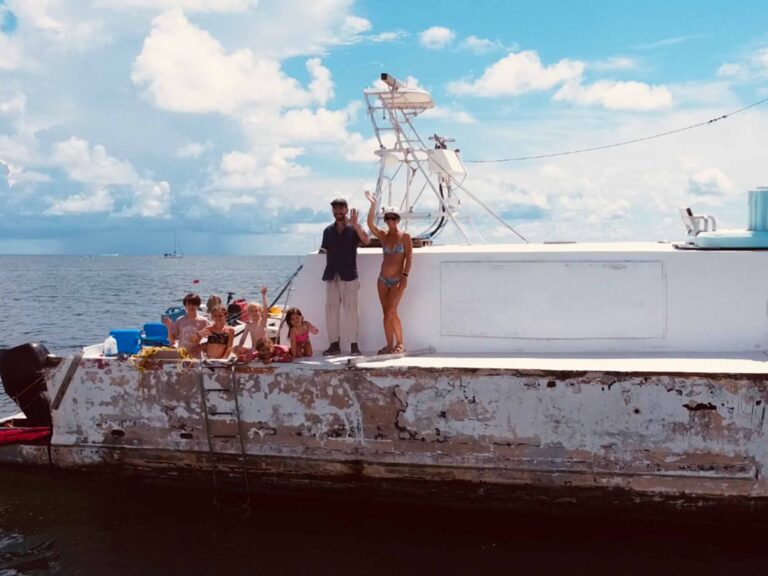
The short answer: Always bring your sense of humor, and always leave your societal cares and woes.
The longer, more complex answer starts with a question: How do you use your boat?
Many folks daysail on the weekends. Fine. They need only the basic tools and supplies to get them back to the dock they just left. However, my wife and I are occasionally at sea for 48 days—and once, in the Indian Ocean, we went four and half months without provisioning because, happily, there is nowhere to provision in uninhabited, blissful Chagos.
Back in the 1950s, when I started out, all offshore vessels were heavy-displacement craft. They had cramped living space but much cargo capacity, which was good because once America faded over the transom, chandleries were almost nonexistent. International payments were nearly impossible. There was no overnight shipping. We attempted to bring everything with us—weight and space be damned.
On my Endurance 35 ketch, Carlotta, in the early 1970s, besides the usual impeller, zincs and filters for our Four-107 engine, I carried a spare head gasket, prop, raw-water pump, starter motor, alternator and four injectors—drawing the line only at a spare diesel fuel pump. This was perfectly normal. Hell, I’ve known boats that carried a complete set of spare sails while shoving off across the Pacific.
However, there were four problems with this approach. One, the weight of all these heavy spares added up. Two, ditto the cost. Three, they took up space. And four, often when you went to use the spare starter motor that you’d so carefully brought aboard seven years and two continents ago, it wouldn’t work. It would have been damaged by salt corrosion. I’ve probably purchased a dozen expensive head-gasket kits that never actually made it into the engine. One drop of salt water beat me to the punch.
Today, boats are lighter and have far less stowage. Even if they could afford the weight, modern boat interiors are optimized to sell at boat shows, not necessarily to function well at sea. There’s barely room to stow a few cans of soup; forget such bulky items as starter motors or delicate items such as head gaskets.
Worst, there’s more and more dependence on electronics and electrical stuff. I’ve happily cruised on vessels with hand-cranking diesels that had no wires going to them whatsoever. My current diesel, however, probably has 20 to 50 electro parts. And, of course, the rusty metal box that houses all these integrated circuits just happens to have ended up directly below our amidships cockpit steering pedestal that gushes water in a full gale like a lawn sprinkler. (I’ve installed an extensive water shed just above the engine to compensate.)
Progress? In terms of fuel economy, perhaps. In other ways, certainly not. And the future is plain: Soon, all injectors will be electronic as well.
I realize that I’m an old fart. Carlotta, along with my 52-foot John Alden schooner, Elizabeth, and my 22-foot double-ender, Corina, all had kerosene running lights. Those Fresnel-lensed Perko units worked pretty well for the 32 years we lived aboard these craft.
Was I unusual in the amount of spares I used to carry? Perhaps. Once, in the Mediterranean, while running late for a wild party on the Italian island of Sardinia, we received a forecast for light airs. We anchored in a Greek cove for a couple of hours to swap out our slipping Hurst transmission. It’s easy if you’ve got the proper tools, and oh, what a party it was! Then again, a DIYer like myself can get carried away. I don’t have a welding machine or a metal lathe aboard, but I envy circumnavigator Tom Lemm of the pinky schooner Le Papillon, who does.
So, what should a prudent modern mariner carry aboard today? If well-heeled, not too much. There are well-stocked chandleries in the Bahamas, Caribbean, Panama Canal, Tahiti, New Zealand, Australia, Singapore, Thailand, South Africa and Brazil. Marine service outlets are everywhere, for a pretty penny.
And, of course, luck plays a part. My buddy Woody was nearing the end of his circumnavigation when lightning struck his boat in the mid-Pacific. After putting out the numerous fires (including paperback books that ignited where they touched chainplates), he happily announced to the crew that he carried a spare electro everything—GPS, VHF radio, depth sounder, alternator and more. Alas, despite each of these units being bone-dry, unconnected and stowed in sealed plastic-foam containers, none of them worked. The force of the lightning strike had been that strong.
Poorly funded or work-as-you-go circumnavigations have to carry far more spares and tools. My stand-up, vise-equipped tool room bristles with mechanical, electrical, plumbing and woodworking tools. I don’t have just an adjustable wrench or two; I have sockets from tiny to inch-and-a-quarter in both imperial and metric sizes for quarter-, three-eighths- and half-inch drives. Plus, a long breaker bar. Open-end and box-end wrenches. Short and long extenders. Torque wrench? Of course. Three sizes of crowbars? Why not?
Do I use these often? Yeah, I do—especially on the boats of friends who don’t know their Loctite adhesive from their Never-Seez lubricant.
But back to the practical advice: You need to carry the stuff that will break. The top of this list is electrical autopilots. If I’m in Auckland, New Zealand, and a friend sails in from the Lesser Antilles, I always say, “I heard you had autopilot problems.” Chances are, it’s true (unless they have a Monitor or other dependable mechanical-steer device like we do).
Next is watermakers. One popular brand eats so much money that owners joke that they should switch to Dom Pérignon because it would be cheaper. Freshwater-pump systems also regularly fail unless you follow their strict maintenance schedule to the letter. Doing so would leave you little time for anything else.
Heads, of course, are crappy to work on. It is everything I can do to not deep-six my two; the only reason I don’t is because I have such a sizable investment in their spares. I carry two complete pumps and a half-dozen joker valves, as well as every moving part, gasket and O-ring in the whole stinkin’ mess.
My engine requires the most spare parts. I now carry a single spare injector and a spare raw-water pump, plus the usual impellers. I carry six each of the primary and secondary fuel filters in case I get a batch of bad fuel. Luckily, neither rusts. However, I carry only two spare lube oil filters because they do rust. (How counterproductive can you get?)
Fluids are another problem. I carry enough oil and five-year coolant to replace what’s inside my engine, plus a few quarts so that I don’t have to deal with gallons in a seaway to top off. Yes, I carry 2 gallons of distilled water for our batteries as well.
We carry a spare prop and carburetor for our wonderfully dependable, ultralight Tohatsu 10-horse. Ditto, a spare meter of Hypalon and extra glue for our Caribe dinghy. (We keep our inflatables carefully covered from the sun at all times, and we get 12 to 14 years of hard, daily use out of them. An amazing value.)
My wife, Carolyn, has a 1950s Pfaff sewing machine that has circumnavigated numerous times aboard various boats. We stock all the threads, grommets, snaps and DOT fasteners to do almost anything fabric-related aboard. Our dinghy cover, sail covers and dodger are all in good nick. Do we make our own sails? No, but when our staysail blew apart in a Pacific gale south of the Cooks, we managed to stick it together long enough to get to New Zealand. Ditto when the entire head of a (used) jib pulled out off the Cocos Islands.
Thanks to our humidity-controlled dry boxes, we don’t have moisture problems with our 12 hard drives, six lenses and two DSLR cameras.
Our Para-Tech sea anchor and Jordan Series Drogue don’t require any spares, and we’re careful about chafe on the 1,200 feet of cordage and spare anchor rode that relates to them. Yes, I carry a spare windlass motor; no, I’ve never used it.
Sadly, the tools I use most often these days are contained in my two small electrical toolboxes. These contain my ohmmeter, test lamps and terminal crimpers. I’d say that I work on my rig about one minute for every hour I work on my too-needy electrical system; those modern conveniences don’t come cheap in terms of weight, space, money or time. Example: I just installed double USBs in the aft and main cabins, as well as at the nav table and fo’c’sle.
The hardest part of preparing for an ocean crossing or circumnavigation is to keep in mind that my life as an offshore sailor is not about the boat; it’s about the voyage. The boat is just a tool. It’s the experience a wise sailor seeks. One reason that I and my lovely bride of 52 years are still on our honeymoon together is because we understand that ease is a false god.
To each his own, of course. Our idea is to sail to Chagos and enjoy Chagos—not to work on our vessel in Chagos. Not to update the autopilot’s firmware. Not to drunkenly shop online from paradise. Do you really think air conditioning improves the cruising experience? I don’t. Electric hatches and davits? Sheet and halyard winches? Vacuum-packed freshwater toilets?
Really?
If you take it all with you, then you’ll never be able to get away from it.
Once, I received a gift of a state-of-the-art satphone from an editor. I politely attempted to refuse, but the publication firmly insisted. One perfect day in midocean, that same publication called me and hollered because of a misplaced comma or something equally trivial. My perfect day wasn’t perfect anymore. I brooded for an hour or two, then told to Carolyn to get our video camera.
“Are you ready?” I asked.
“Yes,” she said. “I’m recording.”
“Excellent,” I muttered as I Frisbee’d the satphone into the 20,000-foot-deep blue sea. At the next port, I sent off a letter. I enclosed the SD card with my resignation letter.
Ah, much better.

